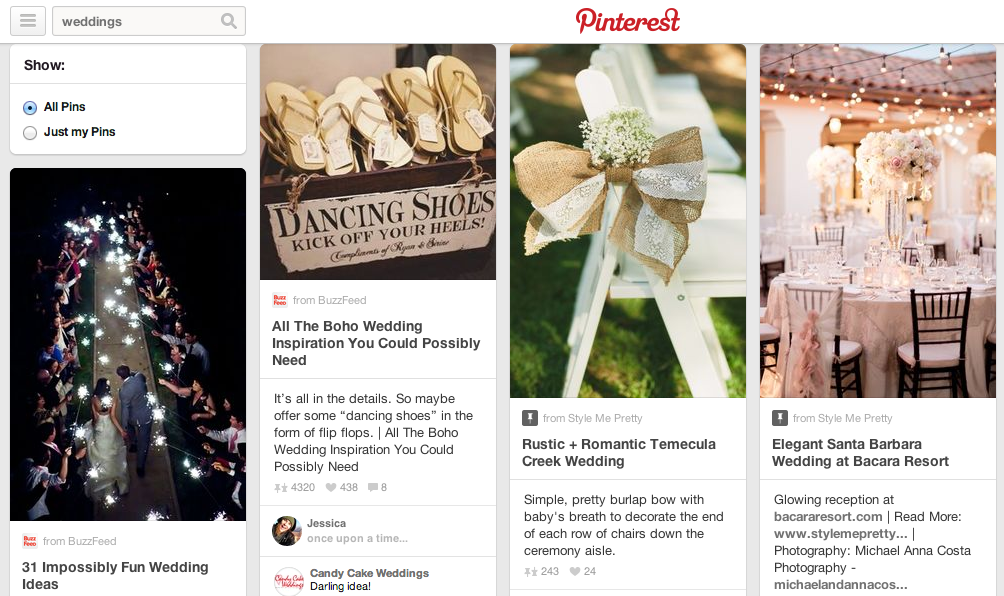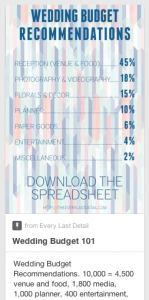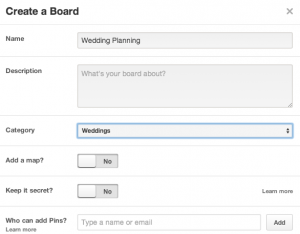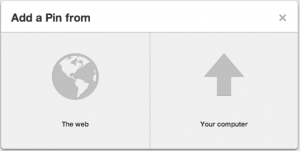This post covers the basics of using Pinterest to promote your business. If you have a Pinterest account for your business and are not using Pinterest’s analytics features then you need to sign up today. If you’re on Facebook consider adding a Pinterest tab app such as this app from Woobox.
Polish Your Profile
Create plan for your boards. What should they be named? How should they be categorized? To get some insight, check out what other brands succeeding on Pinterest are doing. Write a description that’s inline with your brand’s voice. Add your location if it makes sense for your business. Also add your website address and make sure you verify it (shown below).
Create Content Suited to Pinterest
In February 2014, Peggy Wang published a post on BuzzFeed which covered 31 impossibly fun wedding ideas. Six months later pictures from the post are still all over the search results page for “weddings” (I counted 6 pins). If you look at her post you’ll see that it is filled with great photos and fantastic ideas.
By creating content with many hopefully “repinable” photos you increase the chance that one or two of the photos will become highly popular.
Reuse Others’ Photos
Another thing done in the previously mentioned wedding ideas post was that the photos were taken from other sites. Always ask permission before doing this and cite your source. Inform the original photo owners when the post is published as chances are they will share your post with their network. This a a great way to build relationships in your industry. Note: this should only be used once in a while; the majority of your content needs to be original.
What to Pin
First of all, before deciding what to pin you need to come up with a content plan. Pinning the same types of photos over and over to your boards will get dull real quick. Switch between product images, closeups, different settings, various lighting techniques, infographics, et cetera. Keep track of the types of content you pin and the success of each type. Over time you will get an idea of which perform best.
Create and pin content for people at different stages of the purchase/conversion cycle. If you’re selling wedding decorations an infographic on 5 Wedding Planning Tips from the Pros or The Dos and Don’ts of Wedding Planning will reach potential customers at a different point in the purchase cycle then an infographic on Last Minute Wedding Decoration Ideas.
Pin your most popular and best stuff. To follow the wedding decorations example above, post pictures of your top selling products (being used at actual weddings if possible). Be fun, yet not too risky. A wedding topper featuring JFK and Jacqueline Kennedy may get a lot of retweets and so may a wedding topper of JFK and Marilyn Monroe. The former will inspire feelings of romance and a love lost too soon. The latter will inspire feelings of a womanizing and unfaithful husband. Both are equally powerful, which to use depends on your goals and target market.
Below are two examples of pins that make you want to click on the image to view more and one that has a direct call-to-action:
Hashtags on Pinterest
Using hashtags on Pinterest doesn’t help a whole lot when searching for a specific hashtag, well at least not as much as Twitter or other social media platforms. However, hashtags are turned into links on Pinterest. These links go to search queries for the hashtag. You should have a hashtag plan for your overarching social media strategy and use the same hashtags across all platforms. Use hashtags.org to stay up-to-date on popular hashtags.
Relationship Building
I touched on this once already. Pinterest can be a powerful tool to connect with influencers and others in your industry. Pay attention to who is regularly pinning and repinning content in your industry. Also keep track of which sites content is being pinned from. If you have product or services to sell then you will want to be featured on these sites. If you notice certain authors always popping up in your research, work hard to get noticed by them. Sometimes a simple introductory email is all it takes.
Optimizing Your Content for Pinterest
Use keywords when naming your boards and writing titles and descriptions. Pins that have the keyword in the name of the photo file. It’s also beneficial if the URL of the page the image was taken from has the keyword in the URL. So if you’re targeting the search term “wedding cake toppers” your picture could be named something like elvis-las-vegas-wedding-cake-topper. And the image could be taken from a page from www.example.com/products/wedding-toppers. Make sure you choose a proper category for you boards (shown below – left).
Link your pictures to the URL they were taken from. This is done automatically if you choose the image by inputting the URL (shown above – right). Keep descriptions short and to the point. Pictures are the primary focus on Pinterest and nobody wants to read a paragraph about the picture you pinned. Use rich pins to add more data to your pins. Currently there are 5 types of rich pins: movie, recipe, article, product and place. Finally, if you’re on Twitter or Facebook link those profiles to your Pinterest page.
Third-party Pinterest Tools
These tools are recommended by moz.com:
Curalate: This tool helps you measure board and pin engagement, generate traffic, find advocates, and more, depending on the pricing package. It also helps with Instagram.
PinAlerts: Basically Google Alerts for your website’s content on Pinterest, among several other measurement features.
Postris: Helps you find the most popular boards, pins, and people on Pinterest.
Viraltag: A bulk scheduler for Pinterest helps you avoid overwhelming your audience and upload several pins at a time. Viraltag also feature analytics and allows you to upload to multiple Pinterest accounts.
For further reading, check out Moz’s Pinterest guides here (for local biz) and here (non-local). Now get your pin on!






